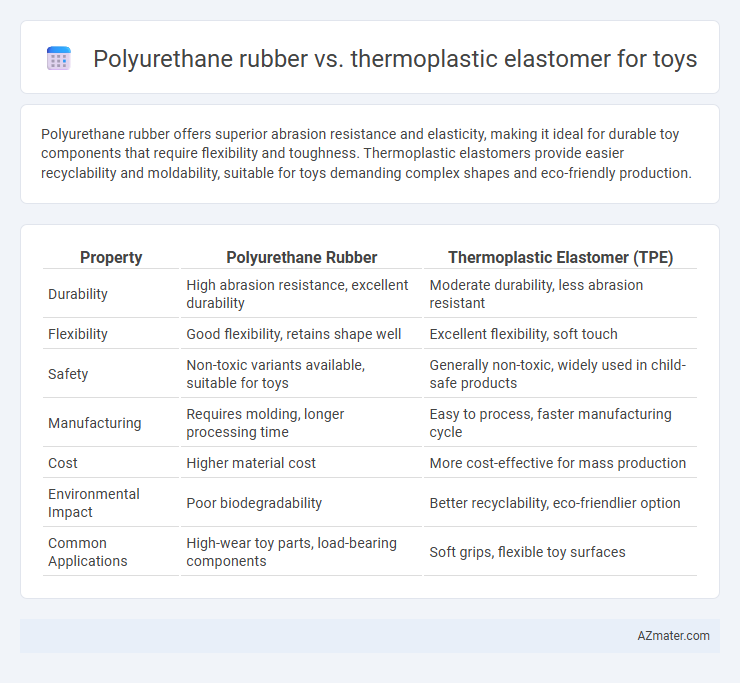Polyurethane rubber offers superior abrasion resistance and elasticity, making it ideal for durable toy components that require flexibility and toughness. Thermoplastic elastomers provide easier recyclability and moldability, suitable for toys demanding complex shapes and eco-friendly production.
Table of Comparison
| Property | Polyurethane Rubber | Thermoplastic Elastomer (TPE) |
|---|---|---|
| Durability | High abrasion resistance, excellent durability | Moderate durability, less abrasion resistant |
| Flexibility | Good flexibility, retains shape well | Excellent flexibility, soft touch |
| Safety | Non-toxic variants available, suitable for toys | Generally non-toxic, widely used in child-safe products |
| Manufacturing | Requires molding, longer processing time | Easy to process, faster manufacturing cycle |
| Cost | Higher material cost | More cost-effective for mass production |
| Environmental Impact | Poor biodegradability | Better recyclability, eco-friendlier option |
| Common Applications | High-wear toy parts, load-bearing components | Soft grips, flexible toy surfaces |
Introduction to Polyurethane Rubber and Thermoplastic Elastomer
Polyurethane rubber offers excellent durability, abrasion resistance, and flexibility, making it ideal for high-performance toy components requiring resilience and longevity. Thermoplastic elastomers combine the characteristics of rubber and plastic, providing easy moldability, recyclability, and soft-touch comfort, which suit mass-produced, lightweight toys. Both materials deliver distinct advantages in toy manufacturing, balancing performance and cost-effectiveness depending on the toy's functional requirements.
Key Properties of Polyurethane Rubber
Polyurethane rubber exhibits exceptional abrasion resistance, high tensile strength, and excellent elasticity, making it ideal for durable toy components that withstand rough handling. Its superior chemical resistance and flexibility at a wide temperature range ensure long-lasting performance and safety in various play conditions. Polyurethane's low compression set maintains shape and cushioning, enhancing comfort and resilience compared to thermoplastic elastomers.
Key Properties of Thermoplastic Elastomer
Thermoplastic elastomers (TPE) offer superior flexibility, excellent impact resistance, and high durability compared to polyurethane rubber, making them ideal for toy manufacturing. Their ability to be easily molded and recycled enhances production efficiency and sustainability in toy design. TPEs also provide excellent resistance to chemicals and wear, ensuring toys remain safe and intact during extended use.
Safety and Toxicity Considerations for Toy Applications
Polyurethane rubber offers excellent durability and abrasion resistance, making it a safe choice for toys that require long-term use, while its chemical stability reduces the risk of toxic leaching. Thermoplastic elastomers (TPEs) provide flexibility and are often formulated to be free from harmful phthalates and heavy metals, ensuring compliance with stringent toy safety regulations such as EN71 and ASTM F963. When selecting materials for toy applications, thorough testing for biocompatibility, migration of harmful substances, and resistance to wear is critical to minimize health risks and ensure child-safe products.
Durability and Wear Resistance Comparison
Polyurethane rubber offers superior durability and wear resistance compared to thermoplastic elastomers, making it ideal for toys subjected to frequent handling and abrasion. Its high tensile strength and excellent resistance to tearing ensure longer-lasting performance under rough play conditions. Thermoplastic elastomers, while flexible and easy to mold, generally exhibit lower abrasion resistance and may degrade faster with constant friction.
Flexibility and Comfort Analysis
Polyurethane rubber offers superior flexibility and resilience, making it ideal for toys that require high durability and repeated bending without deformation. Thermoplastic elastomers provide a softer, more pliable feel, enhancing comfort and safety during tactile play due to their skin-like texture. When comparing both materials, polyurethane rubber excels in mechanical strength, while thermoplastic elastomers are preferred for ergonomic design and user comfort.
Manufacturing Processes and Cost Implications
Polyurethane rubber offers excellent durability and flexibility, making it suitable for intricate toy components produced via injection molding and casting, while its raw material costs and processing times tend to be higher. Thermoplastic elastomers (TPE) enable faster manufacturing through efficient injection molding with recyclability benefits, significantly reducing production costs and enabling easier color customization. Cost considerations favor TPE for high-volume toy production due to shorter cycle times and lower waste, whereas polyurethane rubber is preferred for premium, impact-resistant toy parts despite higher initial expenses.
Environmental Impact and Recyclability
Polyurethane rubber offers durability and elasticity but poses challenges in recycling due to its thermoset nature, leading to increased environmental waste. Thermoplastic elastomers (TPEs) enable easier recyclability and reduced environmental footprint because they can be remelted and reshaped multiple times. Choosing TPE for toys promotes sustainability through lower energy consumption in processing and enhanced material recovery compared to polyurethane rubber.
Suitability for Different Types of Toys
Polyurethane rubber offers exceptional durability and high abrasion resistance, making it ideal for toys subject to rough handling or outdoor use, such as action figures and sports equipment. Thermoplastic elastomers (TPE) provide superior flexibility and softness, well-suited for squeezable toys, teething rings, and toys requiring a latex-like feel. The choice between polyurethane rubber and TPE depends on the toy's intended use, desired tactile properties, and required safety standards.
Conclusion: Choosing the Right Material for Toys
Polyurethane rubber offers superior durability and flexibility, making it ideal for toys requiring high impact resistance and long-lasting performance. Thermoplastic elastomers provide excellent processability and recyclability, suitable for toys needing complex shapes and environmental considerations. Selecting the right material depends on balancing durability, flexibility, environmental impact, and manufacturing needs specific to the toy's design and usage.

Infographic: Polyurethane rubber vs Thermoplastic elastomer for Toy
 azmater.com
azmater.com